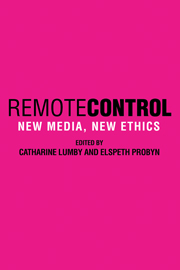Book contents
- Frontmatter
- Contents
- List of Contributors
- Acknowledgements
- 1 Introduction: An Ethics of Engagement
- 2 Real Appeal: The Ethics of Reality TV
- 3 Arguing about Ethics
- 4 ‘Their own media in their own language’
- Beyond the Disconnect: Practical Ethics
- 5 A Viable Ethics: Journalists and the ‘Ethnic Question’
- 6 Ethics, Entertainment and the Tabloid: The Case of Talkback Radio in Australia
- Money versus Ethics
- 7 Eating into Ethics: Passion, Food and Journalism
- Beyond Food Porn
- 8 Ethics impossible? Advertising and the Infomercial
- Pitching to the ‘Tribes’: New Ad Techniques
- 9 Diary of a Webdiarist: Ethics Goes Online
- 10 Control-SHIFT: Censorship and the Internet
- Representing the Asylum Seekers
- 11 The Ethics of Porn on the Net
- Ethics and Sex
- 12 Grassroots Ethics: The Case of Souths versus News Corporation
- 13 Great Pretenders: Ethics and the Rise of Pranksterism
- The Limits of Satire
- Index
7 - Eating into Ethics: Passion, Food and Journalism
Published online by Cambridge University Press: 18 December 2009
- Frontmatter
- Contents
- List of Contributors
- Acknowledgements
- 1 Introduction: An Ethics of Engagement
- 2 Real Appeal: The Ethics of Reality TV
- 3 Arguing about Ethics
- 4 ‘Their own media in their own language’
- Beyond the Disconnect: Practical Ethics
- 5 A Viable Ethics: Journalists and the ‘Ethnic Question’
- 6 Ethics, Entertainment and the Tabloid: The Case of Talkback Radio in Australia
- Money versus Ethics
- 7 Eating into Ethics: Passion, Food and Journalism
- Beyond Food Porn
- 8 Ethics impossible? Advertising and the Infomercial
- Pitching to the ‘Tribes’: New Ad Techniques
- 9 Diary of a Webdiarist: Ethics Goes Online
- 10 Control-SHIFT: Censorship and the Internet
- Representing the Asylum Seekers
- 11 The Ethics of Porn on the Net
- Ethics and Sex
- 12 Grassroots Ethics: The Case of Souths versus News Corporation
- 13 Great Pretenders: Ethics and the Rise of Pranksterism
- The Limits of Satire
- Index
Summary
FOOD AND MEDIA – THE COMBINATION IMMEDIATELY CONJURES UP THE luscious curves of Nigella Lawson as she flirts with the camera, looking straight at us, the wide-eyed, open-mouthed and hungry viewer. For those with other tastes, there's Jamie Oliver, whose ‘mockney’ expressions became part of our vocabulary – ‘pukka’, ‘scrumbly-bubbly’; cool ways and cool food made him the young woman's favoured piece of crumpet. His dishes are simple, and in fact rarely require a recipe – a list of ingredients would do – but he managed to do the unthinkable when he bumped Delia Smith from her position as queen of the kitchen. Delia taught us how to boil an egg and if her turn-on appeal was limited to those with a penchant for schoolmarms, at least no one starved from lack of instruction. In between Delia and Nigella came Nigel Slater, of ‘real food’ fame. Slater was one of the first TV chefs to get down and dirty. He licked and sucked and made eating alone look sexy, if messy. Welcome to the world of food porn.
I've been hooked on food TV ever since The Two Fat Ladies roared onto the screen. Once television food moved out of daytime programming and into the glossy values of primetime I've been watching, feet up on the sofa, glass of wine nearby, and pen and paper in hand. I take notes. I buy the cookbooks. Even stranger, I also cook from the recipes. If the commentary in the media is to be believed, it seems that I'm a lone cook amongst the watchers.
- Type
- Chapter
- Information
- Remote ControlNew Media, New Ethics, pp. 107 - 123Publisher: Cambridge University PressPrint publication year: 2003
- 2
- Cited by

